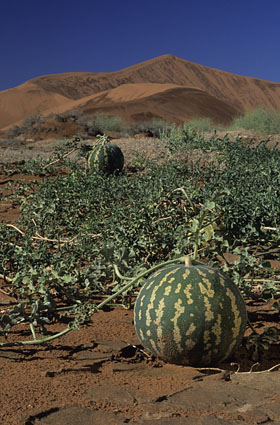 Watermelon is a summertime favorite, grown for its incomparable flavor that once prompted American author and humorist Mark Twain to write, “When one has tasted it, he knows what the angels eat.”
Watermelon is a summertime favorite, grown for its incomparable flavor that once prompted American author and humorist Mark Twain to write, “When one has tasted it, he knows what the angels eat.”
But hidden in the watermelon’s big, sweet shadow are its cousins, the Tsamma melons, similar, yet less sweet vegetables that grow wild in the Kalahari Desert of Southern Africa.
Tsamma melons include several varieties that range in flavor and texture. Botanically, they are the same species as watermelon (Citrullus lanatus) and are widely believed to be ancestors of commercial varieties grown across the world today. The name Tsamma also refers to a species of gourd, Citrullus ecirrhosus, which grows in Namibia and is bitter in flavor.
Like cacti in the deserts of North America, Tsamma melons can store large amounts of water. Traditionally, they have been an important resource for indigenous people of the Kalahari, who store the melons in large numbers as a standby source of water. Some Kalahari people even say that it used to be impossible to travel the desert during any time but melon season.
Tsamma melons, which can be stored for several weeks, have also been an important source of food for many generations. Sweet varieties are eaten raw like watermelons, while the more bitter, tougher varieties are cooked over coals to soften the flesh. Another variety, often referred to as the citron melon, is used mostly for pickling and preserves. Its hard flesh and rind are high in pectin, a fibrous plant compound that is used as a gelling agent in many food products, making the melon excellent for jam.
Nutritionally, the melons have only small amounts of Vitamins A and C, lycopene, and potassium—most varieties are over 90 percent water. However, some varieties, including one known commonly as egusi, are grown not for their flesh or rind but for their highly nutritious, edible seeds. Egusi seeds are high in oil and protein and can be roasted and eaten or ground into a paste similar to peanut butter.
Although watermelons were likely bred from an ancestral Tsamma melon, most varieties of these wild melons remain undomesticated. Many of the less edible varieties lack commercial value and are largely used as subsistence crops, secondary to other, more palatable vegetables. But despite their lack of popularity in local markets, Tsamma melons may prove incredibly useful in plant breeding.
Native to the desert, Tsammas are very drought-resistant, a trait many domesticated watermelons now lack. Plus, Tsammas tend to be smaller and have a variety of interesting colors and plant forms. This genetic material, largely lost in commercial varieties could be used in breeding new varieties of watermelon that could grow in dry conditions or would be more appealing to consumers than the enormous, red ones that are so common.
Tsamma melons are certainly not as big and sweet as their cousin, the watermelon. But their practicality as a source of food and water in the Kalahari Desert has made them an indispensable food to the people there, while their natural tolerance for drought and genetic variety give them great potential for plant breeding.
To learn more about crops indigenous to Africa, see: Reigniting an Interest in Local food, Traditional Food Crops Provide Community Resilience in Face of Climate Change, Monkey Oranges: Mouthwatering Potential, The Green Gold of Africa, Fonio: Africa’s Oldest Cereal Needs More Attention, The Locust Bean: An Answer to Africa’s Greatest Needs in One Tree, Lablab: The Bountiful, Beautiful Legume, Moringa: The Giving Tree, Black-eyed Peas to the Rescue, and The Taming of the Dika: West Africa’s Most Eligible Wild Tree.
Dan Kane is a research intern with the Nourishing the Planet project.

Danielle Nierenberg, an expert on livestock and sustainability, currently serves as Project Director of State of World 2011 for the Worldwatch Institute, a Washington, DC-based environmental think tank. Her knowledge of factory farming and its global spread and sustainable agriculture has been cited widely in the New York Times Magazine, the International Herald Tribune, the Washington Post, and
other publications.
Danielle worked for two years as a Peace Corps volunteer in the Dominican Republic. She is currently traveling across Africa looking at innovations that are working to alleviate hunger and poverty and blogging everyday at Worldwatch Institute’s Nourishing the Planet. She has a regular column with the Mail & Guardian, the Kansas City Star, and the Huffington Post and her writing was been featured in newspapers across Africa including the Cape Town Argus, the Zambia Daily Mail, Coast Week (Kenya), and other African publications. She holds an M.S. in agriculture, food, and environment from Tufts University and a B.A. in environmental policy from Monmouth College.








